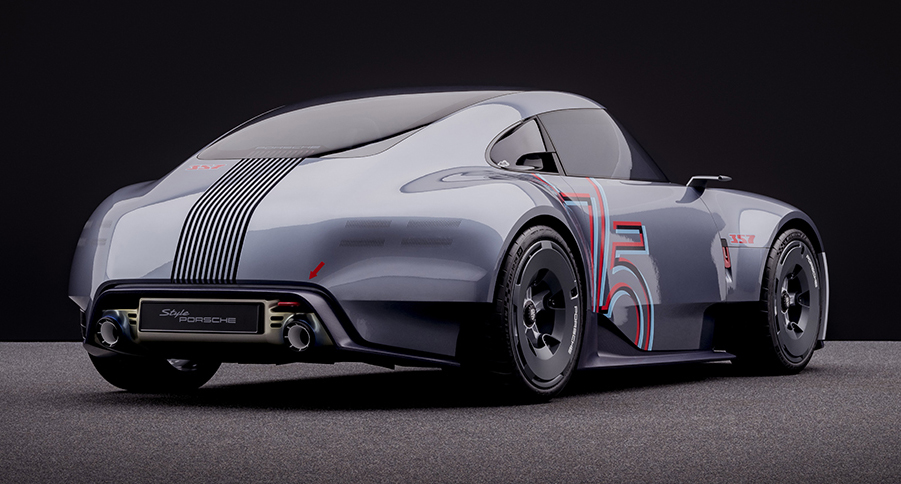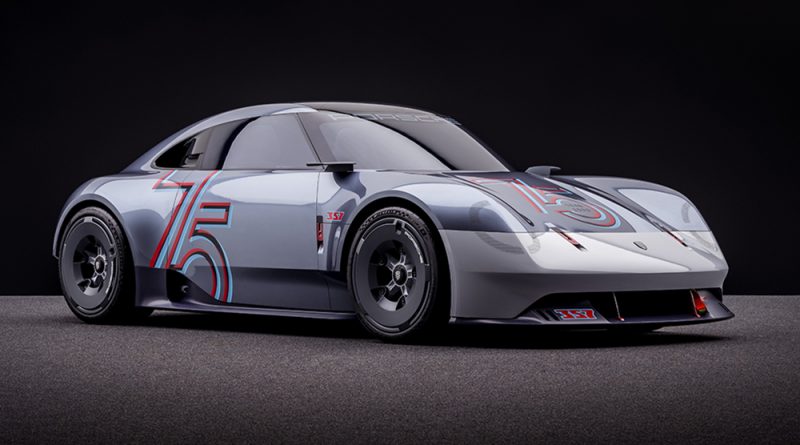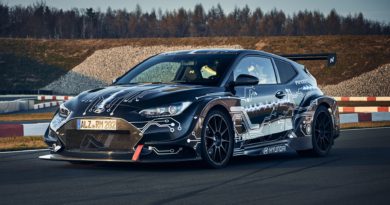Concept car an homage to the first Porsche
Seventy-five years ago, on June 8, 1948, the 356 No. 1 roadster became the first automobile bearing the name Porsche to receive its general operating permit – the birth of the sports car brand. Porsche is now embarking on its anniversary year with Vision 357 and a reference to the Porsche 356 – Ferry Porsche’s dream of a sports car.
As an homage to this, the concept car brings the monolithic form into the present day. Liberated from the regulations that apply for implementation as a series model, the Style Porsche Team manifests potential expressions of the future design philosophy: one example is the consistent enhancement of the light signature, which is progressive and visionary in the way it points towards the future. The fundamental concept is reflective of the interplay between tradition and innovation: what might a sports car of Ferry Porsche look like today?
“We created a very special birthday present in the form of the Porsche Vision 357, one which uses the 356 as a basis to underscore the significance of our design DNA,” said Vice President Style at Porsche, Michael Mauer. “The concept car is an attempt to combine the past, present and future with coherency, featuring proportions that are reminiscent of its historical archetype and details that visualise the outlook for the future.”
Built on the technology platform of the 368kW (493hp) 718 Cayman GT4 RS, Vision 357 represents outstanding sports car performance. The exterior concept study is the highlight of the special exhibition ‘75 Years of Porsche sports cars’ at the Volkswagen Group’s DRIVE Forum in Berlin, Germany, which opened with an exclusive evening event on January 25, 2023. The exhibition will be open to the public from January 27, 2023, and Vision 357 will be exhibited until mid-February. The design study will be presented at the South by Southwest event in Austin, Texas, USA, from March 10, 2023, and at further international events over the year.
Visionary studies and concept cars form the foundation for Porsche’s unmistakable yet innovative design. “Thinking out loud about the future is one of the core missions of Style Porsche. Concept studies are the pool of ideas that feed the design of tomorrow,” said Mauer. “We are perpetually on the conceptual journey into the future of mobility. Time and again, the brand history serves as a source of inspiration. Taking a look back at our tradition with a future concept car is not as paradoxical as it might seem. Creative freedom is also important: this is where valuable ideas can emerge unfettered, ones that help us imagine our consistent design philosophy in innovative new directions.”
MODERN INTERPRETATION OF 356
With its monolithic form, the narrow passenger cell with an abruptly sloping flyline and broad shoulders, the proportions of Vision 357 evoke the lines of 356. The windscreen sharply wraps around the A-pillars. As in its historic forebear, Porsche is pushing the boundaries of glass production: early 356 sports cars had a split windscreen with a bar down the middle. The split design was replaced in model year 1952 by a one-piece windscreen with a bend at the center. The A-pillars of Vision 357 are black and visually unite the side window surfaces into a single unit. This DLO (daylight opening) graphic resembles the visor of a helmet.

The functional details are integrated and underpin the sculptural character of the vehicle. This includes the concealed door openers by the side windows and the tail lights, which sit behind a patterned array of points in the body. Another nod to the original is the grille pattern in the rear, in which the third brake light is integrated. Like all current Porsche models, Vision 357 features a four-point light signet in front. The round design of the headlights is also a throwback to the characteristic lights of 356. There are also parallels in the paintwork: the two-tone concept with Ice Grey Metallic and Grivola Grey Metallic in the nether regions of the front end hearkens back to the grey tones that were popular in the 1950s.
The wide track makes a bullish impression and enhances driving stability. The 20-inch wheels are made of magnesium and are equipped with aerodynamically advantageous carbon fibre hubcaps and central locks. Visually, they also recall a legendary Porsche wheel: 356 A and 356 B with drum brakes had rims with the notably large bolt circle of 205mm.
SPORTY DETAILS FROM 718 CAYMAN GT4 RS
The 75th anniversary logo adorns the doors and the front of the concept car like a race number. There’s nothing behind the lower area of the front wheels, which allows better ventilation of the wheel arches. The wrap-around, jointless front hood is fastened with quick-release mechanisms. Threaded rods stabilise the large front spoiler. On the side sills, Porsche designers employed natural fibre-reinforced plastic (NFRP), as in Porsche Mission R, the concept study for an all-electric GT racing car presented in 2021. The basis for the sustainable materials is provided by flax fibres from agriculture. Instead of traditional exterior mirrors, the concept car is equipped with cameras on the edge of the roof. The visible tailpipe trim in the rear is made of a blueish-looking titanium, while the inside of the tailpipe is made of ceramic.
Like 718 Cayman GT4 RS, Vision 357 has process air intakes positioned high behind the driver- and passenger-side windows, which designers adorned with comic-style ‘Air’ decals. Like the ‘eFuel’ logo on the tank cap on the right wing, the decals are reminiscent of motorsport stickers. The naturally aspirated six-cylinder boxer engine theoretically draws 368kW (493hp) from four litres of displacement. The high-speed mid-engine would be designed for operation with e-fuels.
ABOUT 356 NO. 1
A two-seater with a multi-tubular frame and mid-engine fulfilled Ferry Porsche’s dream of building his own sports car. 356 went into series production as a coupé with a different frame and a 40-PS (39hp) rear engine instead of the original mid-engine concept. This type formed the foundation for the success of the Porsche brand. After the first largely manually built cars (coupé and convertible) 356/2 with an aluminium bodyshell, Porsche moved from Gmünd back to Stuttgart at the end of 1949. This is where series production of the Porsche 356 sports car began. The sheet-steel bodies were manufactured by Stuttgart-based Reutter while engine production began in Zuffenhausen in space rented from Reutter as Porsche Werk 1 was still occupied by the Allies.
Some 78,000 356s were built by 1965. 356 (pre-A, 1948-1955), 356 A (1955-1959), 356 B (1959-1963) and 356 C (1963-1965) were available in a range of open- and closed-top body versions and various performance levels.





